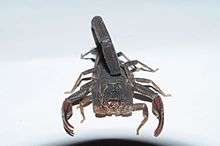Centruroides gracilis
| Centruroides gracilis | |
|---|---|
 | |
| Scientific classification | |
| Kingdom: | Animalia |
| Phylum: | Arthropoda |
| Subphylum: | Chelicerata |
| Class: | Arachnida |
| Order: | Scorpiones |
| Family: | Buthidae |
| Genus: | Centruroides |
| Species: | C. gracilis |
| Binomial name | |
| Centruroides gracilis (Latreille, 1804) | |
Centruroides gracilis is a species of scorpion in the family Buthidae, the bark scorpions. Its common names include Florida bark scorpion, brown bark scorpion, and slender brown scorpion.[1][2] In Cuba it is known as alacran prieto ("dusky scorpion") and alacran azul ("blue scorpion").[1] It is native to northern parts of the middle Americas, including Mexico, Guatemala, Belize, and Honduras. It is present in other parts as an introduced species, including Cuba, Panama, Colombia, Ecuador, Jamaica,[3] and Florida in the United States. It is also introduced in parts of Africa, including Cameroon and Gabon, as well as the Canary Islands.[1]
The female of the species reaches up to 10 centimeters in length, while the male can exceed 15 centimeters. It is variable in color, sometimes with individuals of different colors occurring in one population, or even one litter. It may be reddish, black with reddish chelae, dark brown with yellowish legs and red chelae, or dark brown with reddish and black tail sections.[1]
The female gives birth to a litter of 25 to 35 young,[4] with litters of 91 recorded. The juveniles ride on the female's back and undergo their first molt at eight days of age. A study of captive scorpions revealed the length of their life cycle. The juveniles progress through instar stages, sometimes dying of complications with the molting process. The female reaches maturity in roughly 300 days, after seven instars, but the males mature at different rates. Some reach sexual maturity in the sixth instar, at about 235 days of age, while some are not mature until the seventh instar, around 281 days old. At mating, the male engages in courtship behavior and produces a spermatophore.[5] Females can reproduce via parthenogenesis, as well.[6] In the laboratory the males had an average life span of about 33 months, while the females lived about 38 months.[5]
This scorpion feeds on insects such as roaches.[2] Captive scorpions can be fed termites or crickets.[7]
The scorpion lives under rocks and tree bark. When given the opportunity it will live in the walls of houses and under rubbish piles in yards.[1]
Predators of the scorpion include the tarantula Brachypelma vagans. The tarantula may kill the scorpion even if it is the scorpion that attacks first.[8]
The scorpion is venomous, but much less toxic than others of its genus. Its venom is neurotoxic and cardiotoxic, causing the release of catecholamines. Local effects from the sting can include pain, redness, itching, and swelling. The venom can produce cardiac effects such as arrhythmia, pulmonary edema, tachycardia or bradycardia, and hyper- or hypotension. Other possible symptoms include nausea, vomiting, sweating, diarrhea, shock, convulsions, coma, and potentially death.[9]
This species is sometimes kept as a pet.[4]
References
- 1 2 3 4 5 Rein, J. O. Centruroides gracilis. The Scorpion Files. Norwegian University of Science and Technology, Trondheim. 2012.
- 1 2 Muma, M. H. (1967). Scorpions, whip scorpions and wind scorpions of Florida. In: Arthropods of Florida and Neighboring Areas, Volume 4. Division of Plant Industry. Florida Department of Agriculture.
- ↑ Teruel, R. (2008). Confirmation of the occurrence of Centruroides gracilis (Latreille 1805) (Scorpiones: Buthidae) in Jamaica. Boletín Sociedad Entomológica Aragonesa 42 370.
- 1 2 Centruroides gracilis. Institute for the Study of Invasive Species. Texas State University.
- 1 2 Francke, O. F. and S. K. Jones. (1982). The life history of Centruroides gracilis (Scorpiones, Buthidae). J Arachnol 10 223-39.
- ↑ Teruel, R. (2004). Primer registro de partenogénesis en Centruroides gracilis (Latreille, 1804) (Scorpiones: Buthidae). Revista Ibérica de Aracnología 9(30) 141-42.
- ↑ Culbert, D. Florida Scorpions. University of Florida IFAS Extension, Okeechobee County. April 10, 2005.
- ↑ Dor, A., et al. (2011). Predatory interactions between Centruroides scorpions and the tarantula Brachypelma vagans. Journal of Arachnology 39(1) 201-204.
- ↑ Centruroides gracilis. Clinical Toxinology Resources. The University of Adelaide.